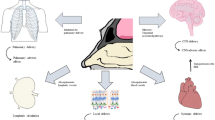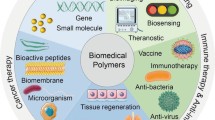Abstract
The narcotic antagonist naltrexone (I) was modified at the 3 and 14 hydroxyl positions and covalently coupled to a biodegradable poly(α-amino acid) backbone through a labile bond. Selective acetylation of I with acetic anhydride gave naltrexone-3-acetate (II), which was subsequently succinoylated to naltrexone-3-acetate-14-hemisuccinate (III) with succinic anhydride. The polymeric backbone chosen for initial coupling experiments was poly-N 5-(3-hydroxypropyl)-L-glutamine (PHPG). The side-chain hydroxyl functionality permitted covalent bonding of III through an ester linkage. Hydrolysis of covalently bound drug to give naltrexone or its derivatives (II and III) should be much slower than diffusion of drug through the polymer matrix. While hydrolysis of naltrexone from the polymer side chain is first order, release of drug from the matrix can be zero order due to the geometry of the device and the physical and chemical interactions between naltrexone and the polymer matrix. In vitro studies of PHPG–naltrexone conjugate in disk form did not show constant release because of the hydrophilic nature of the polymer backbone and the changing local chemical environment upon hydrolysis of drug–polymer linkages. The conjugated system was made more hydrophobic by coupling drug to copolymers of hydroxypropyl-L-glutamine (HPG) and L-leucine. Conjugates of III coupled with copoly(HPG-70/Leu-30) demonstrated a nearly constant, but slightly declining release rate of naltrexone and its derivatives for 28 days in vitro.
Similar content being viewed by others
REFERENCES
C. Theis. In R. Willette (ed.), Res. Monogr. Ser. 4, National Institute on Drug Abuse, 1976, pp. 19–20.
C. Theis. ACS Symp. Ser. 32:190 (1976).
K. R. Sidman, D. L. Arnold, W. D. Steber, L. Nelson, F. E. Granchelli, P. Strong, and S. G. Sheth. In R. Willette (ed.), Res. Monogr. Ser. 4, National Institute on Drug Abuse, 1976, pp. 33–38.
D. L. Wise, A. D. Schwope, S. E. Harrigan, D. A. McCarthy, and J. F. Howes. In R. J. Kostelnick (ed.), Polymeric Delivery Systems, Gordon and Breach, New York, 1978, p. 75.
S. Yolles, J. Eldridge, R. Leafe, J. H. R. Woodland, and F. Meyer. In A. C. Tanquary and R. E. Lacey (eds.), Controlled Release of Biologically Active Agents, Plenum Press, New York, 1974.
J. Heller. J. Contr. Rel. 2:167 (1985).
H. B. Hopfenberg. In D. R. Paul and F. W. Harris (eds.), Controlled Release Polymeric Formulations, American Chemical Society, Washington, D.C., 1976.
D. E. Gregonis, J. Feijen, J. M. Anderson, and R. V. Petersen. ACS Polymer Preprints 20:612 (1979).
R. V. Petersen, J. M. Anderson, S. M. Fang, J. Feijen, D. E. Gregonis, and S. W. Kim. ACS Polymer Preprints 20:20 (1979).
N. Lotan, M. Bixon, and A. Berger. Biopolymers 8:247 (1969).
M. Miyake, S. Akito, A. Teramoto, T. Norisuye, and J. Fumita. Biopolymers 13:1173 (1974).
J. Feijen, D. Gregonis, C. Anderson, R. V. Petersen, and J. Anderson. J. Pharm. Sci. 69:871 (1980).
C. Still, M. Kahn, and A. Mitra. J. Org. Chem. 43:2923–2925 (1978).
N. Lupu-Lotan, A. Yaron, A. Berger, and M. Sela. Biopolymers 3:625 (1965).
P. H. von Dreele, N. Lotan, V. S. Ananthanarayanan, R. H. Andreatta, D. Poland, and H. A. Scheraga. Macromolecules 4:408 (1971).
P. Y. Chou, M. Wells, and G. D. Fasman. Biochemistry 11:3028–3043 (1972).
K. Itakura, N. Katagiri, C. P. Bahl, R. H. Wightman, and S. A. Narang. J. Am. Chem. Soc. 97:7327 (1975).
W. A. R. Van Heeswijk, G. J. Brinks, and J. Feijen. In E. Chiellini and P. Giusti (eds.), Polymers in Medicine, Plenum, New York, 1984, pp. 147–156.
C. Linder and J. Fishman. J. Med. Chem. 16:553 (1973).
F. I. Carrol, C. G. Moreland, G. A. Brine, and J. A. Kepler. J. Org. Chem. 41:996 (1976).
R. M. Silverstein, G. C. Baseler, and T. C. Morrill. Spectrometric Identification of Organic Compounds 4th ed., Wiley, New York, 1981, pp. 249–290.
M. Perez-Reyes and M. E. Wall. In R. Willette and G. Barnett (eds.), Res. Monogr. Ser. 28, National Institute on Drug Abuse, 1981, pp. 93–101.
Author information
Authors and Affiliations
Rights and permissions
About this article
Cite this article
Negishi, N., Bennett, D.B., Cho, CS. et al. Coupling of Naltrexone to Biodegradable Poly(α-Amino Acids). Pharm Res 4, 305–310 (1987). https://doi.org/10.1023/A:1016493103302
Issue Date:
DOI: https://doi.org/10.1023/A:1016493103302




